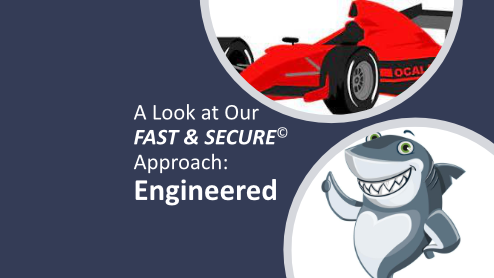
Welcome to our second focused article on our FAST & SECURE© approach.
Find, Assess, Share, and Trust the data through a Specifically Engineered process for Client-focused Usability, Reliability and Enforcement.
We will be looking at the term Engineered, and how it fits into our approach to eDiscovery. According to the Webster Dictionary, Engineer is defined as
1: To lay out, construct, or manage as an engineer a bridge
2: To contrive or plan out usually with more or less subtle skill and craft engineer a business deal.
3: A designer or builder of engines
a: A person who is trained in or follows as a profession a branch of engineering.
b: A person who carries through an enterprise by skillful or artful contrivance.
4: A person who runs or supervises an engine or an apparatus.
We know that the software platforms have been engineered and designed to support many file formats, or to represent data with different visualizations, or with Artificial Intelligence to speed up our reviews. The engineering behind these features alone is what directly benefits us as users of the platforms. Knowing that each of the platforms goes through a rigorous development lifecycle, and then stands the test of the courts should be a comfort to all its users. However, there are still opportunities for enhancements, issue resolutions, and the like to be completed by the platform developers, and thus why service providers, law firms and corporations will have a maintenance window or planned downtime for the system.
However, not every project has the exact same data, requirements, custodians, corporate culture / policies, or team members. Rather it is a unique combination of all of these (and more) that make the project what it becomes. Let’s expand on these items for a moment:
Data
Data types are ever changing; new applications are coming onto the market that are not currently supported by the platforms. The Scope of the Data being collected is changing – remember when it was just Paper, or just the WordPerfect Suite, or Microsoft Office, or…. the list has continued to grow to now include data in the social media (Facebook, Twitter, etc.) space and now the Collaborative Team Sharing Applications (Teams, Zoom, GoToMeeting, etc.), where each of these have a different format with their own nuances.
Requirements
Each project may follow some general steps, the EDRM (Electronic Discovery Reference Model) is a notable example, where we have been able to standardize the process, but the devil is in the details. And those requirements can change dramatically depending on what the Matter / Investigation is about. The requirement to have certain data integrated into the collection that is not supported by the platform is a common issue that all of us address regularly. We need to engineer a process that is outside of the platform to address the requirement, and then we need to integrate the results back into the platform. How features of the platform are used to get to the desired outcome can also mean devising approaches that leverage individual components and then through those individual results allow for a consolidated dataset to be identified and then moved on to another stage of the review process.
Custodians
Each custodian is another unique factor to the project. How an individual organizes their data (files or email) ; or where they store the data; what tools and applications they use, can introduce other considerations that as a project management team we may need to address. Further a custodian’s understanding of the matter / investigation will also determine the quality of the response that we receive when they are asked questions as part of a custodian survey / interview.
Corporate Culture / Policies
Similar to custodians, each corporation can have its own culture and policies around information governance and the lifecycle(s) that data may follow. These can introduce considerations that need to be accounted for within the overall project.
Team Members
Newer Team Members may or may not have the same level or experience with eDiscovery issues, concepts, or matter/investigation approaches. With this comes educational opportunities that can benefit all team members, with a goal to make the process more thorough and complete.
So, when you look at these, I am sure that you can produce other factors that contribute to the overall complexity of the matter. With that comes the balance of “doing it the same way” or following a specific process or engineering innovative approaches and methodologies that truly meet the requirements. And yes, we are all learning, encountering new data, new situations, looking for that next feature that will truly meet our needs. Together, as a team, we work to build the best process we can, based on industry standards (like the EDRM, and the various workflows that platform vendors have developed).
Would you like to learn more about our services? Email [email protected] or call 289-803-9730. We would be happy to share more details about our self-service or fully managed eDiscovery services!





